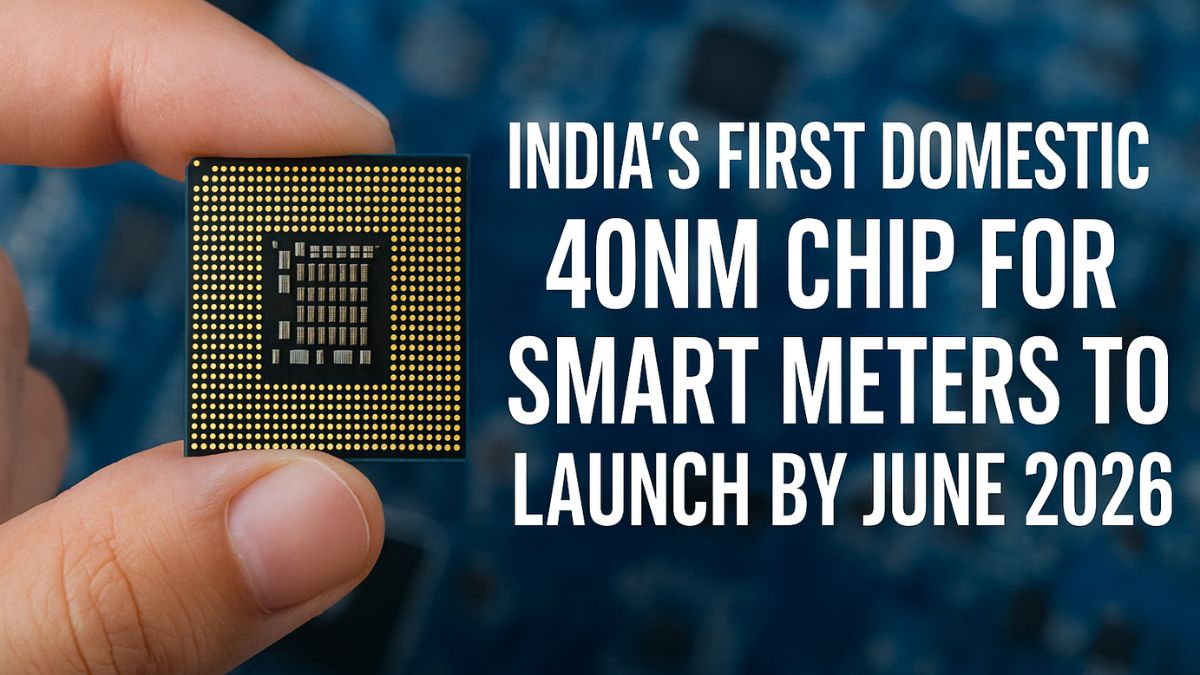India first 40nm chip for smart-meter applications is set to enter the market by June 2026, marking a breakthrough moment in the country’s semiconductor and electronics manufacturing landscape. Engineering solutions firm Cyient confirmed that its in-house semiconductor division is designing and developing India’s first-ever 40-nanometre (nm) system-on-chip (SoC), a milestone that could significantly reduce import dependency and strengthen India’s ambition of becoming a global chip-design hub.
The announcement is viewed as a strategic shift for India’s electronics sector, especially at a time when the government is aggressively pushing the Make in India, India Semiconductor Mission (ISM) and localisation policies to expand the domestic supply chain for energy, mobility, digital infrastructure and consumer electronics.
A Major Leap in India’s Semiconductor Journey
For decades, India has been heavily reliant on imported semiconductors for smart meters, smartphones, automobiles, defence equipment, consumer electronics and telecom devices. While India has built strong design and software capabilities, local manufacturing and in-house chipset development have lagged behind global competitors.
Cyient’s 40 nm chip announcement changes that trajectory.
The company revealed that the new SoC is being designed at its domestic VLSI centres and will undergo fabrication through a global foundry partner. The chip is specifically optimised for smart electricity meters, one of India’s fastest-growing digital infrastructure markets, driven by the government’s plan to install 250 million smart meters nationwide.
Why the 40nm Chip Matters for India’s Power Sector
Smart meters are central to India’s digital power infrastructure strategy. They enable:
- Real-time consumption monitoring
- Automated billing
- Remote disconnection/reconnection
- Load forecasting and grid balancing
- Reduction of power theft
- Greater transparency between consumers and DISCOMs
Until now, almost all smart-meter chips were imported, primarily from Taiwan, China and Europe.
A domestically designed India first 40nm chip brings several advantages:
- Lower hardware costs (15–20% reduction expected)
- Better supply-chain resilience
- Energy-efficient performance
- Customization for Indian grid conditions
- Full IP ownership within India
Cyient confirmed that the upcoming chip is engineered to operate efficiently in India’s wide climate and voltage conditions, addressing issues found in certain imported chipsets.
High Demand: India to Install 250 Million Smart Meters
Under the Revamped Distribution Sector Scheme (RDSS), the Indian government is accelerating the rollout of prepaid and postpaid smart meters. The scheme aims to reduce aggregate technical and commercial (AT&C) losses from nearly 23% to below 12% in coming years.
Industry estimates show:
- Nearly 40 million smart meters already deployed
- An additional 200+ million to be installed by 2030
- More than ₹1.5 lakh crore in contracts awarded
This makes India the largest smart-meter market in the world, surpassing the EU and Southeast Asia.
Having a domestic chip at the heart of this infrastructure dramatically improves national energy security and strengthens domestic electronics innovation.
Boost to India’s Semiconductor Ecosystem
The launch aligns with the government’s semiconductor strategy — focusing on chip design, local IP creation, and eventual wafer manufacturing.
India’s strengths in semiconductor design are well established:
- Over 20% of global chip designers are Indian
- More than 50 semiconductor design companies operate in India
- India produces high-skilled engineers for VLSI, embedded systems and chip testing
However, localising chip architecture and IP has remained a challenge.
The India first 40nm chip represents:
- Indigenous architecture
- Lower licensing costs
- Stronger self-reliance
- Technology ownership within India
- aim to build an end-to-end electronics ecosystem.
🔗 PLI Scheme Details:
https://www.meity.gov.in/esdm/pli
This could inspire more Indian companies to move deeper into chip design for automotive, IoT, medical devices, telecom and aerospace.
Government Push: Make in India + Digital India + Energy Reforms
The launch is in sync with several national missions:
India Semiconductor Mission (ISM)
Providing incentives for chip design, fabless companies and R&D.
Make in India & Atmanirbhar Bharat
Reducing dependence on imported electronics components.
Smart Meter National Programme
Digitising power infrastructure for efficiency and transparency.
Power Industry: Get Power Industry Latest News, Power Industry Updates | The Economic Times
Digital India
Strengthening IoT and connected-device ecosystems.
Energy ministry officials have welcomed developments such as this, saying it will help India meet its targets quicker and with more cost efficiency.
Technical Highlights of the 40nm Smart-Meter Chip
Cyient has shared early-stage specifications:
- 40nm process technology (energy-efficient, robust)
- Integrated communication module (NB-IoT / RF mesh / 4G LTE options)
- Low-power SoC design for field operation
- Secure hardware architecture to protect against power-theft tampering
- Wide operating temperature tolerance
Officials say the first engineering samples will be fabricated by late 2025, with field tests beginning in early 2026.
Challenges Ahead
India’s semiconductor journey is not without challenges:
- Lack of domestic wafer fabrication
- Shortage of high-end VLSI specialists
- Heavy reliance on foreign EDA tools
- High R&D costs for advanced nodes
- Competitive global chip market
But industry experts say India is taking a step-by-step approach, starting with chip design (where India has strength) before moving into fabrication.
Research by Deloitte highlights that India must scale both talent and infrastructure to sustain semiconductor growth.
🔗 Deloitte Report:
https://www2.deloitte.com/in/en/pages/technology-media-and-telecommunications/articles/semiconductor-industry-outlook.html
Global Opportunities Emerging
If successful, India could export this chip to markets like:
- Southeast Asia
- Middle East
- Africa
- South America
regions that are beginning smart-meter modernisation programmes but lack affordable chipset options.
Indian-designed chips could become competitive alternatives to European and Chinese designs, especially in cost-sensitive markets.
Conclusion
The development of India first 40 nm chip marks a landmark moment in India’s semiconductor and digital infrastructure journey. As smart meters become the backbone of modern energy distribution, a domestic chipset gives India strategic control, cost advantage and global export potential.
If the rollout stays on schedule, India may soon transition from being the world’s largest consumer of smart-meter technology to becoming a global supplier of smart-meter chipsets—a leap that will define the next decade of India’s electronics innovation.
Stay tuned to Huffindia.com for latest updates


























